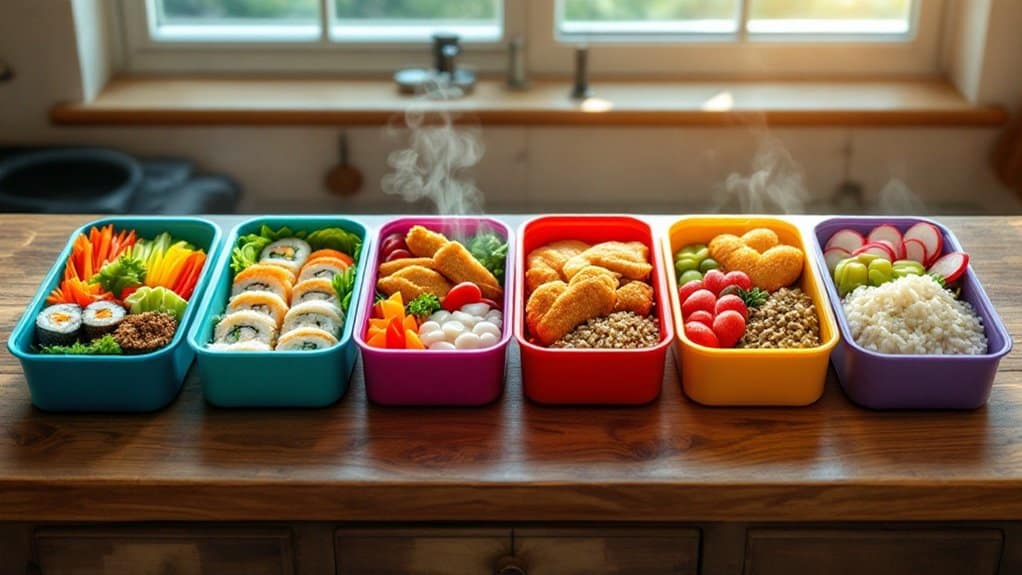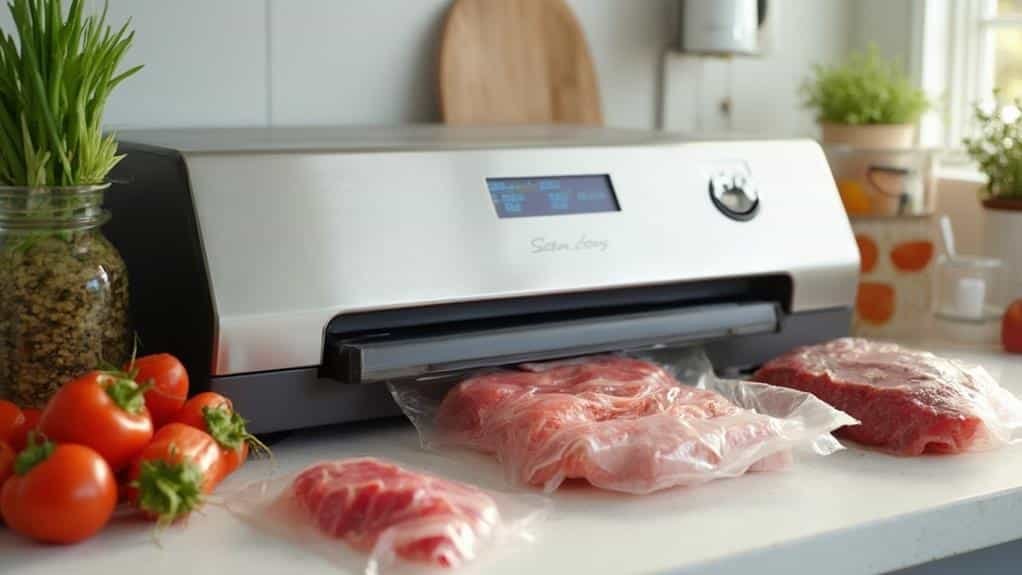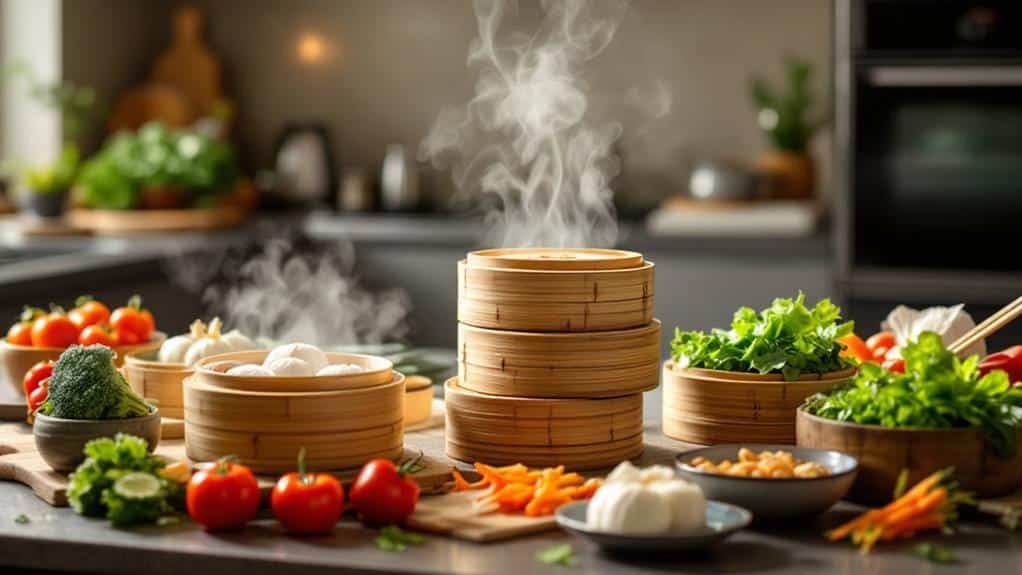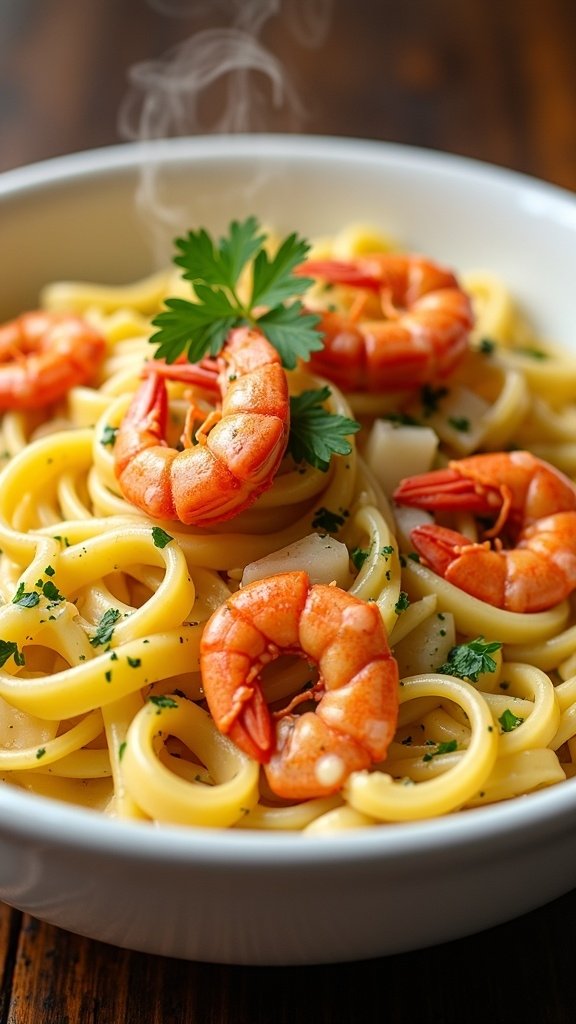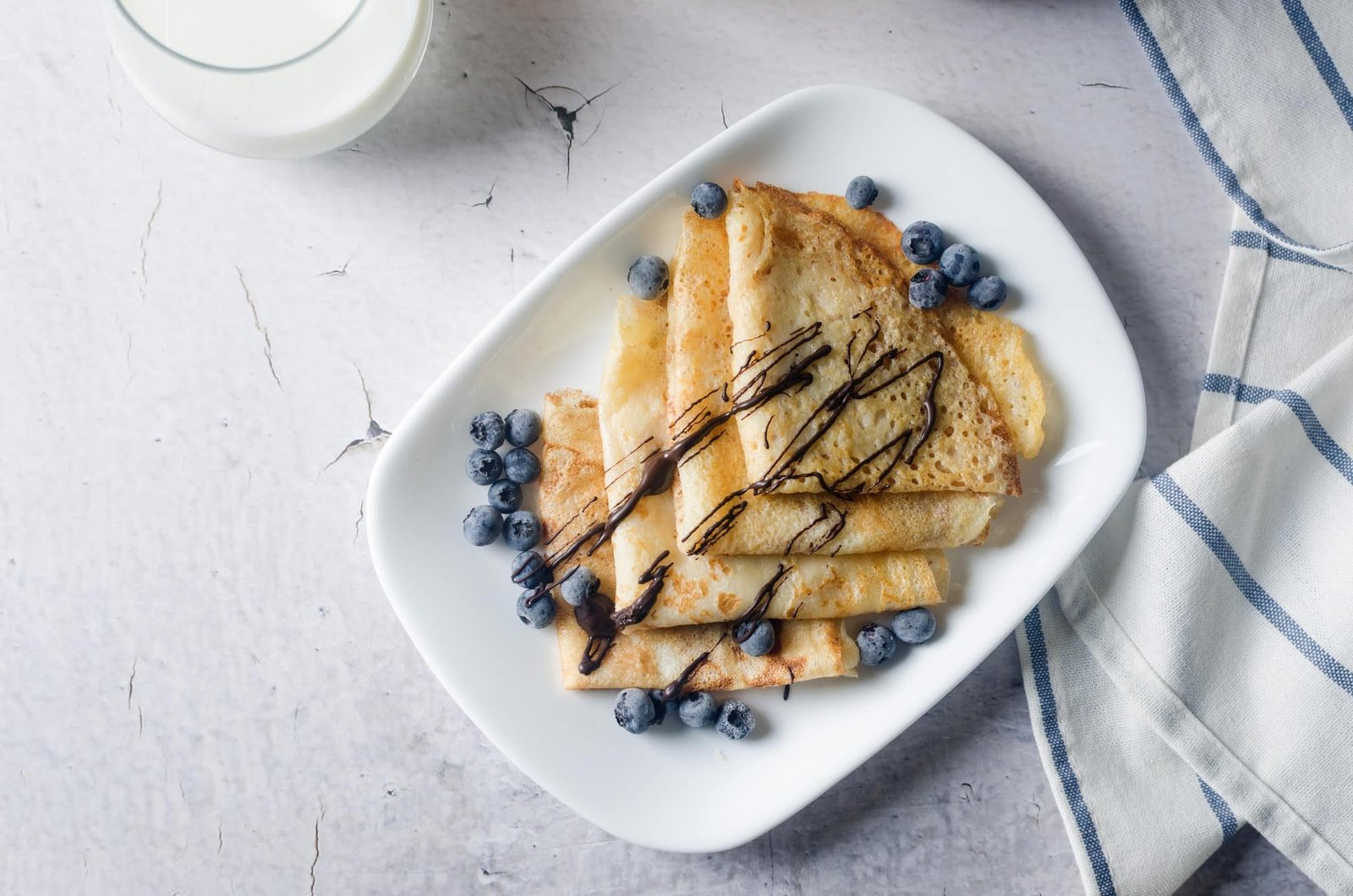Weekly bento prep is a game-changer that transforms your lunch routine from mundane to magnificent. You’ll save significant money (up to $75 weekly compared to takeout) while ensuring you’ve got balanced, visually appealing meals ready to grab and go each morning. By dedicating just a few hours on Sunday to thoughtful prep and assembly, you’ll create Instagram-worthy lunches that follow the 3-2-1 rule (three parts carbs, two parts veggies, one part protein). Plus, you’ll avoid those dreaded afternoon energy crashes with properly portioned, nutritious meals that keep you fueled throughout the day. Let’s explore how this Japanese-inspired lunch system can revolutionize your midday meals.
Weekly Bento Prep Key Highlights
- Weekly bento prep saves $50-75 per week by replacing daily takeout with bulk-bought ingredients prepared in advance.
- Organized compartments ensure balanced portions of carbs, proteins, and vegetables, promoting healthier eating habits and sustained energy.
- Sunday prep sessions create an efficient workflow, saving valuable morning time and reducing weekday lunch-packing stress.
- Pre-portioned ingredients and thoughtful presentation increase meal anticipation and satisfaction compared to hastily assembled lunches.
- Strategic ingredient planning reduces food waste while maintaining variety through creative combinations and overlapping components.
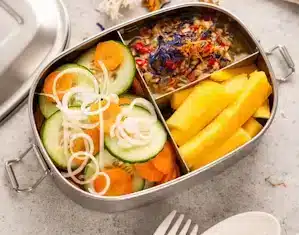
In this Article
What Are Bento Boxes
Bento boxes are traditional Japanese lunch containers that feature multiple compartments to hold different food items in a visually appealing and organized way. You’ll find these charming boxes have been part of bento history for centuries, dating back to the 5th century when Japanese workers needed portable meals for long days in the fields.
In bento culture, presentation is just as important as the food itself. You’re not just tossing a sandwich and chips into a bag – you’re creating an artistic arrangement that’ll make your coworkers peek over your shoulder at lunchtime (trust me, they will).
The compartments aren’t just for show – they serve a practical purpose by keeping your foods separate and fresh. Think crispy tempura, staying crunchy while your rice remains perfectly steamed. It’s like having a mini restaurant experience right at your desk.
Modern bento boxes come in various materials, from traditional lacquered wood to practical BPA-free plastic. You’ll find them ranging from simple designs to elaborate character-themed boxes that’ll make you feel like a kid again (but with much better lunch options). Today’s popular options like the JBGOYON Bento Box offer generous 1900ml capacities with leak-proof compartments perfect for adult portions.

Benefits of Weekly Bento Prep Meal Planning
Now that you understand what bento boxes are let’s explore how planning these lunches ahead of time can transform your week.
When you dedicate a few hours on Sunday to meal prep, you’re setting yourself up for incredible nutritional benefits. You’ll naturally make healthier choices when planning rather than grabbing whatever’s available when hunger strikes.
The cost savings are remarkable, too. Instead of spending $12-15 daily on takeout lunches, you’ll pay a fraction of that by buying ingredients in bulk and preparing them yourself. You’d be amazed how quickly those lunch expenses add up!
Planning your bento boxes weekly means you’ll always have a balanced meal waiting for you. No more 3 PM energy crashes from that greasy food truck burger you grabbed in desperation.
You’ll also save precious morning time – no more rushing around trying to throw lunch together while simultaneously brewing coffee and hunting for your keys. Just grab your pre-prepped bento from the fridge and go.
The best part? You’ll look forward to lunchtime, knowing a thoughtfully prepared meal is waiting for you.
Tools like bamboo steamers and rice cookers can make your weekly meal preparation more efficient and enjoyable.
Essential Bento Box Equipment
Before diving into weekly meal prep, you must gather the right tools for bento success. Start with the star of the show – your bento box. Whether you choose a traditional Japanese multi-compartment style or a modern Western design, ensure it’s leak-proof and appropriately sized for your appetite.
Essential tools for your bento journey include silicone cups for separating foods, small sauce containers, and decorative food picks. You’ll also want to invest in a set of mini cookie cutters – they’re perfect for transforming ordinary ingredients into fun shapes that’ll make your lunch more exciting.
Don’t forget the practical items that’ll make prep time smoother. A good rice paddle, sharp knife, and cutting board are must-haves. I learned this the hard way when I tried making onigiri with a regular spoon – let’s just say it wasn’t Instagram-worthy!
Storage containers for pre-cut vegetables and some ice packs will round out your bento toolkit. Remember, you don’t need to buy everything at once. Start with the basics and build your collection as you develop your bento-making skills. Adding a digital kitchen scale to your toolkit ensures precise portions and helps maintain balanced nutrition in your bento boxes.
Balancing Your Bento Components
Creating a well-balanced bento starts with understanding the traditional 3-2-1 rule: three parts carbohydrates, two parts vegetables, and one part protein. This time-tested ratio guarantees you’ll feel satisfied and energized throughout your afternoon without that dreaded post-lunch slump.
When selecting protein options, you’ll want to think beyond the usual sandwich meats. Consider incorporating grilled chicken, hard-boiled eggs, or marinated tofu. I’ve found that mixing up protein sources keeps lunch exciting while meeting your nutritional needs.
Aim to include raw and cooked vegetables in different colors for vegetable variety. This isn’t just about nutrition – it’s about creating a visually appealing meal you’ll look forward to eating.
Incorporating low-glycemic ingredients like bok choy and bamboo shoots can help maintain stable blood sugar levels throughout your workday.
Here’s why balanced bentos make such a difference:
- They keep your energy levels stable through slow-releasing carbs
- They satisfy your hunger with the perfect protein-to-fiber ratio
- They make portion control effortless through built-in compartments
Time-Saving Prep Strategies
Smart meal prep is the foundation of efficient bento making. When you master time management for your weekly bento routine, you’ll transform chaotic morning rushes into smooth sailing. Think of it as creating your personal lunch assembly line!
Start by dedicating an hour on Sunday for ingredient organization. Wash and chop vegetables in bulk, portion proteins, and cook rice or grains that last through the week. Store everything in clear containers – you’ll thank yourself later when you’re bleary-eyed on Wednesday morning.
Create a prep station workflow that makes sense for your kitchen. Keep your cutting board, knife, and containers within arm’s reach. You’d be surprised how many minutes you save just by not hunting for that one container lid that always seems to disappear!
Batch similar tasks together: all the chopping at once, all the cooking at once. It’s like being your own sous chef. Pre-portion ingredients into daily amounts, and you’ll practically be able to pack your bento with your eyes closed.
Remember: Future You will be incredibly grateful to Past You for this organized approach.
Consider using vacuum sealers for ingredients you won’t use immediately to prevent freezer burn and extend freshness.
Storage and Food Safety
All that careful prep work pays off only when you store your ingredients properly. Following proper food storage and safety guidelines isn’t just about keeping your food fresh – it’s about protecting your health and maximizing your meal prep investment.
Your refrigerator is your best friend in bento prep. Keep it at or below 40°F (4°C) and organize ingredients in clear, airtight containers. You’ll want to label everything with prep dates – trust me, by Wednesday, you won’t remember when you cooked that rice!
Here’s what makes proper storage so essential for your weekly bento success:
- Properly stored ingredients maintain their texture and flavor, so your Thursday lunch is just as delicious as Monday’s
- Safe food handling prevents foodborne illness, keeping you energized for those afternoon meetings instead of stuck at home.
- Smart storage extends the life of your prep work, saving you both time and money in the long run.
Remember to separate raw and cooked ingredients, and never let prepared foods sit at room temperature for more than two hours. When in doubt about an ingredient’s freshness, it’s better to toss it than risk getting sick. Reusable containers of durable stainless steel or glass are ideal for maintaining food quality while reducing environmental waste.
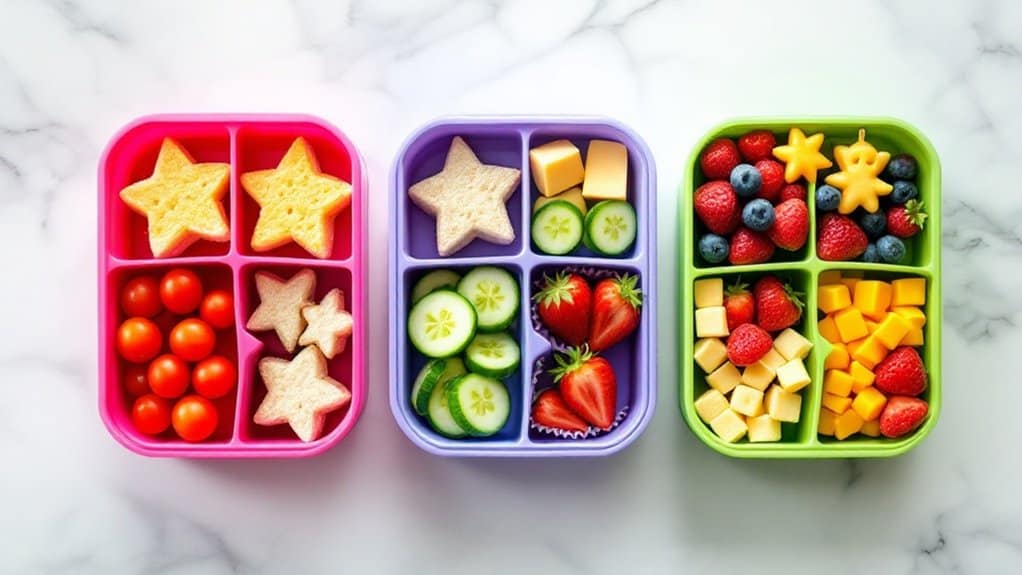
Kid-Friendly Bento Prep Ideas
Making bento boxes exciting for kids doesn’t require fancy techniques or special tools. You’ll find that children are naturally drawn to colorful ingredients and simple shapes that make their lunch feel memorable and fun.
Start with familiar favorites as your base – sandwiches cut into stars, cheese cubes, or rolled turkey slices. Then, add pops of color with cherry tomatoes, cucumber wheels, and rainbow fruit. These fun bento recipes work best when you follow the “eat the rainbow” principle, making the meal as visually appealing as it is nutritious.
Try creating simple themes your kids will love. A “woodland” bento might include a bear-shaped sandwich, forest-green broccoli “trees,” and mushroom-shaped cheese cuts. An “ocean” theme could feature fish-shaped cucumber slices and blue rice with nori seaweed details.
Don’t forget to involve your little ones in the planning process. When kids help choose their bento components, they’re more likely to eat them. Keep a list of their favorite combinations, and rotate through them during your weekly prep sessions.
Remember: Sometimes, the simplest ideas make the most significant impact. A smiley face made from raisins can turn an ordinary lunch into a memorable meal.
Natural food coloring can transform ordinary rice into vibrant hues that make bento boxes more engaging for children.
Weekly Shopping and Budgeting
Planning your bento ingredients around a solid shopping budget helps you maintain the fun and variety without overspending. When creating your weekly grocery budgeting plan, check what’s already in your pantry and what’s on sale at your local stores.
Savvy bento shoppers know that meal variety doesn’t have to break the bank. You’ll want to build your shopping list around seasonal produce and rotating protein options. Those colorful bell peppers that seem expensive? They’re actually quite affordable when you slice them into portions for multiple bentos.
Quality storage containers are essential investments that help maximize the longevity of your prepared ingredients.
Here’s why strategic shopping transforms your bento game:
- Buying in bulk and portioning saves up to 40% on staple ingredients like rice, noodles, and proteins
- Seasonal shopping means fresher ingredients at lower prices – your bentos will taste better and cost less
- Planning multiple bentos with overlapping ingredients reduces waste and stretches your dollar further
Remember to keep an inventory of your bento supplies running. It’s surprising how that forgotten package of nori or that extra container of edamame can inspire next week’s creations while keeping your grocery budget in check.
Weekly Bento Prep Frequently Asked Questions
Can I Use Bento Boxes for Hot Foods Like Soup or Stew?
You’ll need specialized soup containers for hot liquids, not regular bento boxes. Use insulation methods like thermal food jars or vacuum-sealed containers to safely keep your soups and stews hot until lunchtime.
How Do I Prevent Rice From Becoming Hard in Refrigerated Bento Boxes?
You’ll keep rice soft by letting it cool completely before storage. Sprinkle water on top before reheating, or use proper rice storage techniques like wrapping in plastic while it’s still slightly warm.
Are Traditional Japanese Bento Boxes Better Than Modern Western Alternatives?
While traditional Japanese bento boxes offer authentic aesthetics and compartments, you’ll find modern Western alternatives equally effective. It’s really about your priorities – whether you value traditional design or modern convenience features.
Can I Freeze Complete Bento Box Meals for Longer Storage?
Yes, you can freeze complete bento meals! You’ll want to separate wet and dry ingredients using proper freezing techniques. Packing rice and main dishes separately during bento prep for ideal results is best.
What’s the Best Way to Transport Bento Boxes Without Spilling?
You’ll prevent spills by using leak-proof lids and packing your bento box upright in an insulated bag. Secure any liquid items in separate containers, and wrap the box with an elastic band for extra protection.
Putting it all Together for Your Weekly Bento Prep
Weekly bento prep isn’t just about packing a pretty lunch – it’s about transforming your midday meals into something you’ll look forward to. You’ll save money, eat healthier, and feel more organized throughout your week. Whether you’re a busy parent, working professional, or someone who wants to elevate their lunch game, bento prep can revolutionize your routine. So grab those dividers and get started – your future self will thank you!

